We’ve all seen those old photos of the early days of Walt Disney World’s EPCOT Center. Some of us have been in a few of these photos, or even taken them ourselves. Well, old is new, retro is in, and EPCOT has turned forty years young! To celebrate, let’s take a look at the pavilions of Future World in ye olde EPCOT. Along the way, we’ll explore the icons created for these once cutting-edge slices of “Edutainment.”
Spaceship Earth
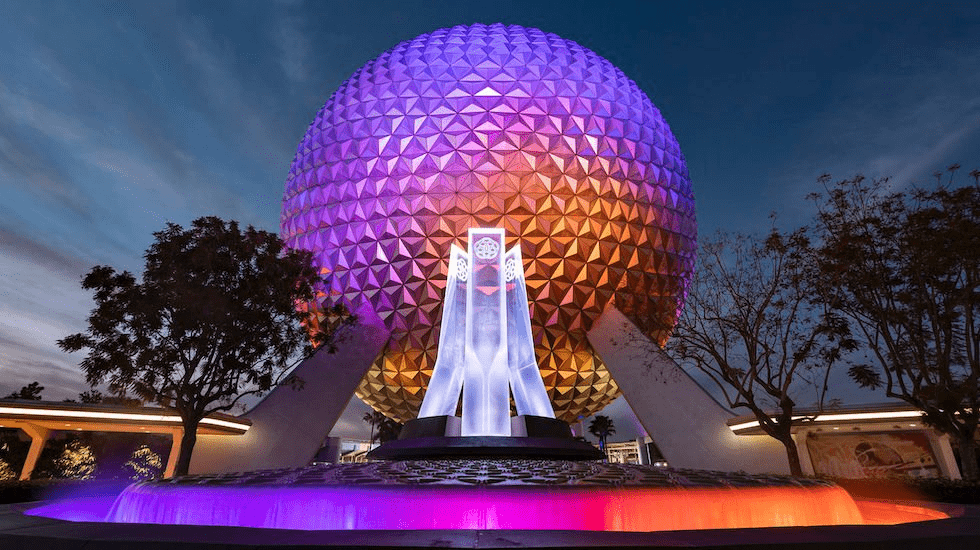
How else would we start off our list? With the granddaddy of them all, of course – Spaceship Earth. This emblem of EPCOT (and the park’s tallest structure) stood tall on day one in 1982, and still serves as the park’s gorgeous icon to this day. The striking evening color combination of blues, yellows, oranges, and pinks has filled up many a camera roll (or camera phone storage space) for awe-struck visitors, and remains one of the most photographed locations in the world. The geodesic sphere was given a gorgeous exterior refresher in 2021, making it even more beautiful than ever.
Inside the sphere, guests slowly spiral to the top as they are told the story of communication throughout the history of humankind. Highlights of our progress include the development of early language through cave paintings, the use of hieroglyphs, the invention of the alphabet, the creation of the printing press, and the modern advancements of today’s technology (well, almost today’s technology).
Spaceship Earth has had several sponsors throughout the years, and has gone through several refurbishments. Through it all, the story has always stayed true to its mission of celebrating the progress of communication throughout history.
The Spaceship Earth Icon

Our “Grand and Miraculous Spaceship” soars with purpose through the larger cosmic realmin this classic EPCOT icon.
World of Motion
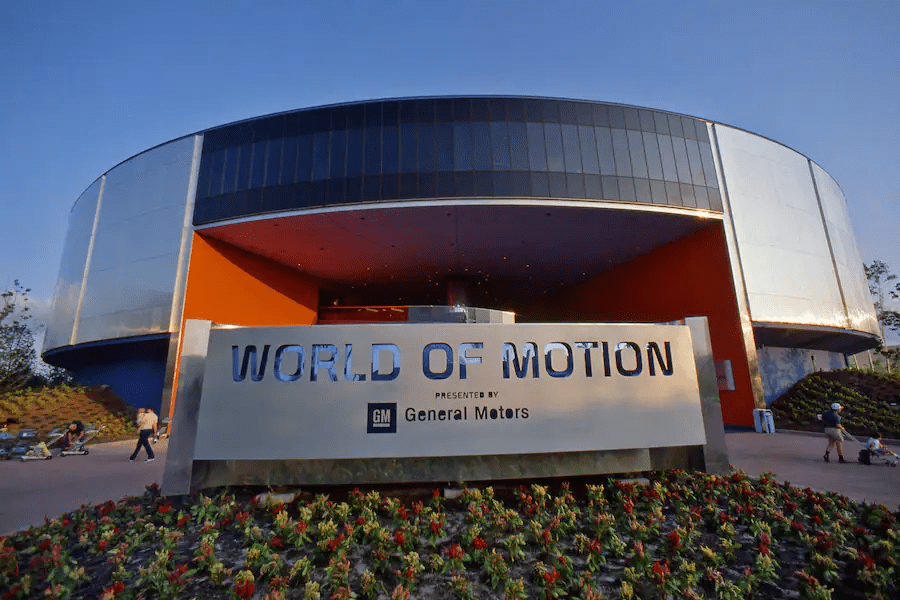
The best way to prepare for the future is to study the past, and the attractions in Future World were instrumental in teaching us about the world before our time, so we could look ahead to our future. World of Motion opened with the rest of the park on October 1, 1982, telling the story of transportation from the earliest days of foot travel, through inventions like the wheel, boats, motorized engines, and flight, straight on to a peek at the future of transportation.
Two veteran Disney animators – Ward Kimball and Marc Davis – lent their unique brand of cheeky humor to an otherwise Edutainment-based attraction. Both of these Disney Legends were on the doorstep of retirement when called upon to create World of Motion, so it was fitting that they took this last drive together. Together, they created a whimsical look at history and achievements in transportation, showing scenes from the ancient days of foot power right up to the present day, and even a peek into the future. This drive back through time featured well north of 100 audio animatronics figures, making World of Motion one of the attractions with the most audio animatronics in Disney Parks history.
World of Motion closed in January 1996. It was reimagined and reopened as Test Track in 1999.
The World of Motion Icon

Bold and directional – this simple yet descriptive icon shows the movement of a single point in space. The vibrations scattering outwardly from the path of the point’s forward momentum remind us that matter is everywhere – even in the air we breathe.
Universe of Energy
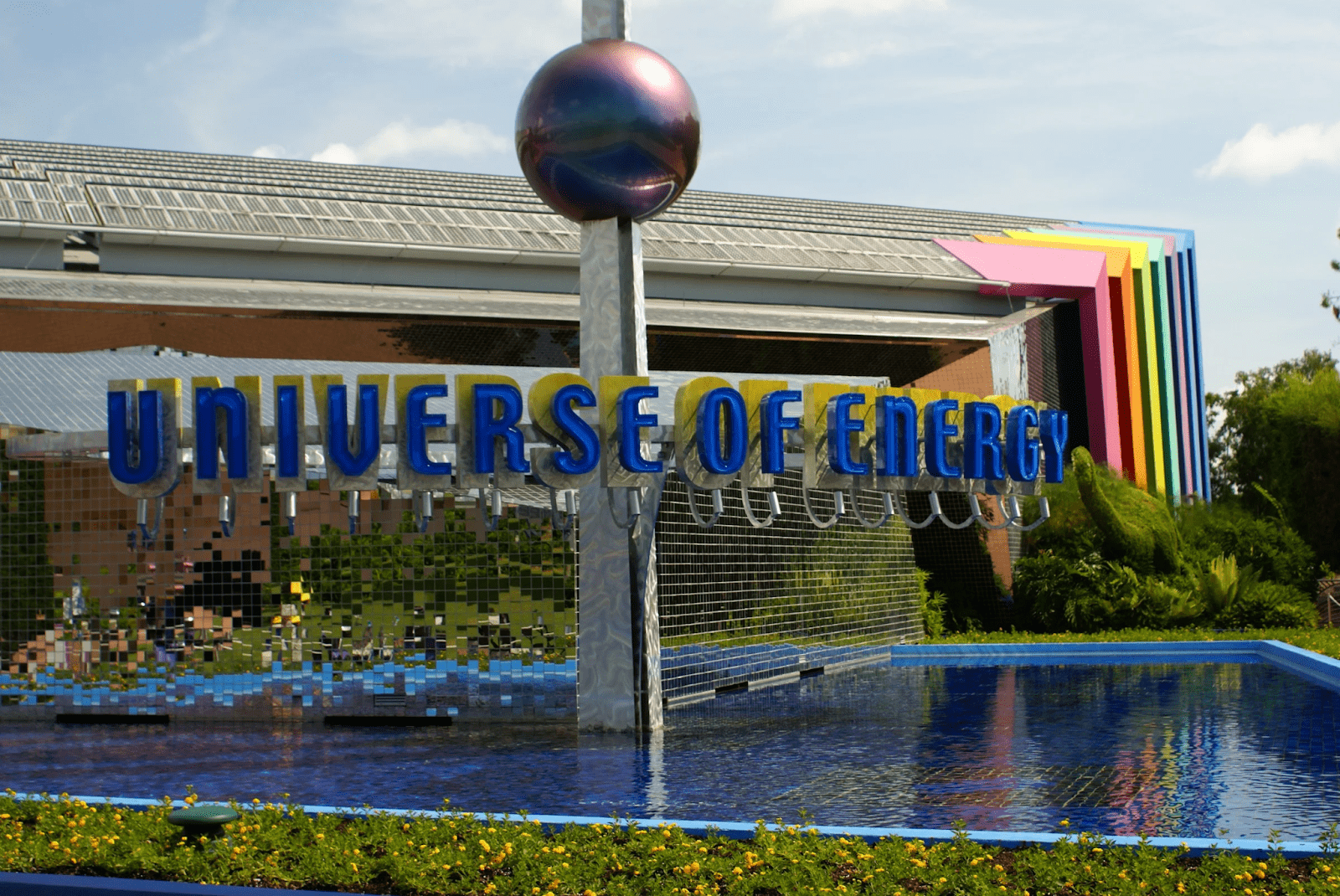
The concept of energy discussion is not one that fuels a social party, but Disney Imagineers were determined to include this core concept in EPCOT’s progressive plans. Imagineers worked up a pavilion and attraction dedicated to all forms of energy – including fossil fuels (which were sponsor Exxon’s bread & butter).
In designing Universe of Energy’s ride system, Imagineers sought to move large volumes of people through static stages of the attraction experience. They took the Carousel of Progress’ concept of large, mobile, audience-style seating and pushed it a step further, creating a block of seats that began in “audience mode” but would then split apart to give small groups of guests their own more intimate experience while moving through multiple show scenes and through a Dinosaur Diorama.
Universe of Energy was a big draw when EPCOT first opened, but by the mid-1990s its popularity had faded. Many of the concepts introduced in the attraction were no longer so new or revolutionary, and many guests were underwhelmed and unamused by the serious tone of the attraction. In short – the attraction wasn’t very fun, especially to an increasingly impatient audience. Universe of Energy closed for good in September 1996, and was reimagined into Ellen’s Energy Adventure, which opened in September 1995. Ellen entertained guests for over 21 years, closing in 2017 to make way for Guardians of the Galaxy: Cosmic Rewind – EPCOT’s first “otherworldly” pavilion.
The Universe of Energy Icon

Energy is often illustrated as either a lightning bolt or an explosion of some sort. For Universe of Energy, the image of a reverberating shock illustrates how energy is truly generated. The sudden force of power starts small and condensed, and spreads through an outward series of ripples. It’s that simple.
CommuniCore

EPCOT Center’s “Community Core” was the embodiment of what early EPCOT was meant to represent – a collection of science and technology exhibits created to teach guests about cutting-edge scientific advances.
While the pavilion’s name suggests a singular hub of information, CommuniCore was actually broken out into two crescent-shaped buildings. The buildings were located immediately behind Spaceship Earth, and were separated by an open air courtyard space, from which rose a grand fountain.
CommuniCore’s central location and multi-faceted focus areas were meant to evoke a futuristic version of Main Street, USA. But digging a little deeper, one could see how the entrance placements into CommuniCore’s two buildings connected them to each of the six existing Future World pavilions, creating a natural parallel to each pavilion’s scientific focus. Spaceship Earth may be the heart of EPCOT, but once upon a time, CommuniCore was considered the “brain” of the park.
After serving as EPCOT’s Main Street for over a decade, CommuniCore’s once cutting edge technologies began to show their age. Seeing a need to refresh CommuniCore’s content, the pavilion started closing in stages in 1993. Imagineers updated the pavilion for a new generation, and the area opened once again in July 1994 as Innoventions (most of which has now been dismantled and in the process of being reimagined yet again).
The CommuniCore Icon

For guests familiar with the layout of early EPCOT Center, the CommuniCore icon looks fairly straightforward – two mirror-image crescent-shapes surrounding a central open space. This simple pictogram looks almost exactly like an overhead view of the pavilion itself. With CommuniCore being the “brain” of early EPCOT, this icon also doubles as the human brain’s left and right hemispheres.
Horizons
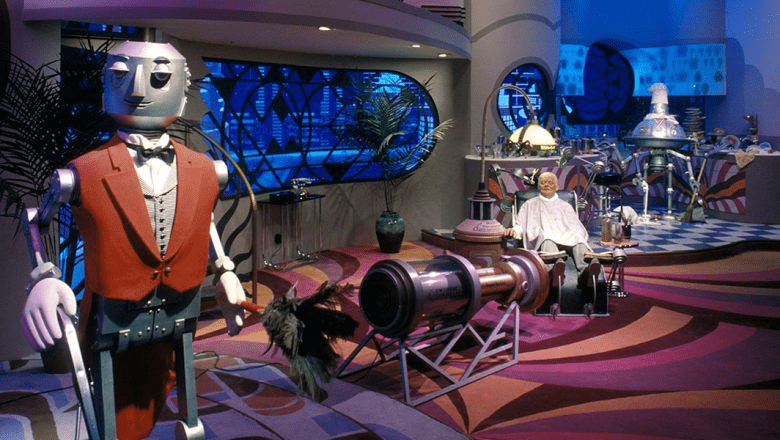
Horizons was the first non-opening day pavilion added to Future World. The concept for an attraction looking at life in the future was an anchor of the EPCOT Center project right from the start. It was (and still is) the only attraction in EPCOT’s history to incorporate all of the elements of the park’s spirit – communication, energy, transportation, anatomy, imagination, education, and humankind’s relationship to the land and the sea.
Horizons debuted in October 1983, a year after the park. Both the pavilion and the attraction tied together all the concepts of EPCOT with a look toward a promising future. The attraction experience functioned like a two-act story, bridged with a larger-than-life intermission. Act One took a look at “past visions of the future” as perceived from the era of historical visionaries. Act Two was an optimistic look ahead to the future (or, the “horizon”) of society. Here, guests saw how technology could allow the human race to further expand and colonize such unreachable areas as outer space, the ocean floor, and vast deserts.
Horizons is widely considered to be the “spiritual successor” to Walt Disney’s Carousel of Progress, which was initially sponsored by GE at the 1964-1965 World’s Fair. The attraction dazzled guests for a decade, but closed in December 1994 following the loss of its sponsor General Electric. Horizons was pressed into service in December 1995 to satisfy guests in EPCOT while Universe of Energy and World of Motion were closed for refurbishments. The attraction’s second life lasted a little over three years, until it closed permanently in January 1999. The nostalgic fan-favorite attraction was replaced with Mission: SPACE, which opened in 2003.
The Horizons Icon

Anyone who has taken a class involving drawing/design knows the term “vanishing point.” It is the point in space which is supposed to appear the furthest from the viewer. It is also defined more technically as the position at which all receding parallel lines meet. The Horizons icon uses the concept of a vanishing point to draw guests forward along a measured plan toward that always bright future.
Journey Into Imagination

“One little spark…”
These three words represent the heart of Journey Into Imagination. The only original Future World pavilion to not be based on hard science – it is instead themed to human imagination, creativity, and the arts. Housed in a bright glass pyramid behind whimsical leaping fountains, the pavilion beckoned to children (and children at heart) more than any other early Future World pavilion in EPCOT’s early days.
Journey Into Imagination – the attraction – came online about five months after the pavilion opened. The attraction introduced guests to a tiny pink and purple dragon who would become the unofficial mascot of EPCOT Center. Figment, along with his partner Dreamfinder, have been fan favorites ever since they were first introduced. The Journey Into Imagination attraction was, at the time, the most advanced dark ride in theme park history. It has been reimagined twice since its initial conception, though it has never been received with the same popularity as the original version.
Aside from what is affectionately known as “the Figment attraction”, the Journey Into Imagination pavilion (since renamed “Imagination!”) has hosted several shows in the adjacent theater, including Captain EO (starring Michael Jackson), Honey I Shrunk the Audience, and Disney and Pixar Short Film Festival.
The Journey Into Imagination Icon

Smile! If you think the icon for the Imagination pavilion looks like a camera shutter…you’re correct. Kodak – the pavilion’s original sponsor – was well-represented in the pavilion. The icon indeed serves as an eye to imagination. Aside from the icon, Kodak products and processes were highlighted in various areas of the Imageworks walkthrough portion of the pavilion. And Figment’s adorable yellow and red sweater directly reflects Kodak’s corporate color scheme.
The Land
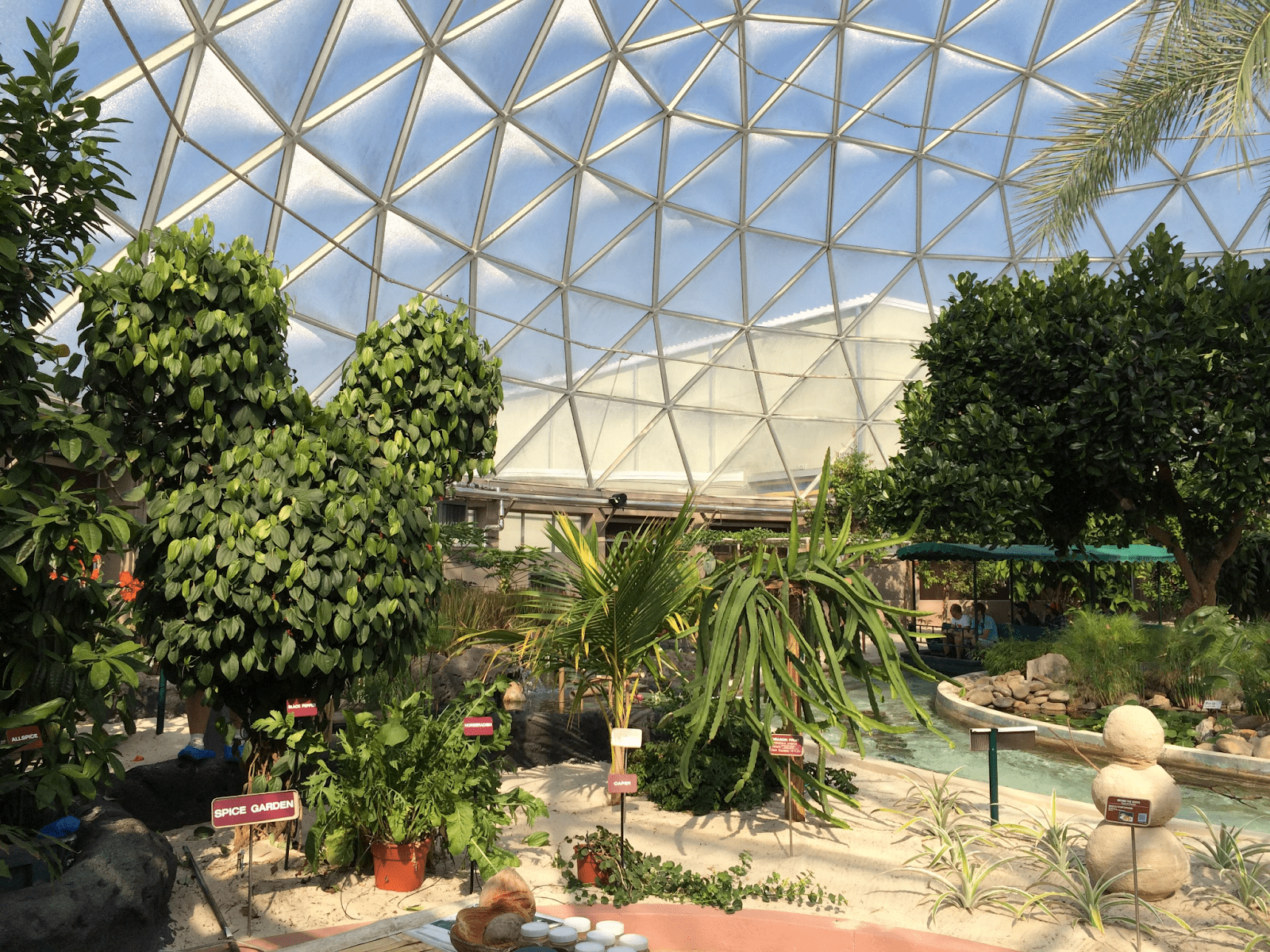
Unlike almost every other pavilion in the former Future World, The Land has never been fully rethemed. This opening day pavilion was dedicated to human interaction with the Earth, focusing on agriculture, conservation, and travel. With a shrinking world battling many natural challenges, these same messages resonate stronger now than ever before.
This large pavilion has featured more attractions during its history than any other pavilion in Future World. Listen to the Land – a gentle boat ride introducing guests to the history of agriculture and its innovations – was refreshed in 1993 as Living With the Land. Kitchen Kabaret was a charming stage show full of amusing audio-animatronics fruits and vegetables. It was replaced in 2004 with Food Rocks, which amplified the original stage show by featuring parodies of classic songs. The stage show theater was demolished and replaced in 2005 with simulator film Soarin’ Over California (more recently refreshed as Soarin’ Around the World) – one of the most beloved attractions in any Disney park. Symbiosis was a film exploring the balance between technological expansion and environmental protection. It was replaced in 1995 by Circle of Life: An Environmental Fable, and more recently Awesome Planet, both of which tell much the same story to guests.
In addition to being an entertaining pavilion, The Land is also a demonstration, production, and research facility – committing 43,000 square feet to experimental horticulture techniques in hydroponics, irrigation methods, and integrated pest management. Some of this research is presented to guests floating by on Living with the Land, but guests who want to learn more can dig deeper into these agricultural innovations on the Behind the Seeds backstage tour.
The Land Icon

Shapes of leaves and tones of green stand out amidst an outline of planet earth in this simple – yet poignant – icon of the pavilion.
The Living Seas
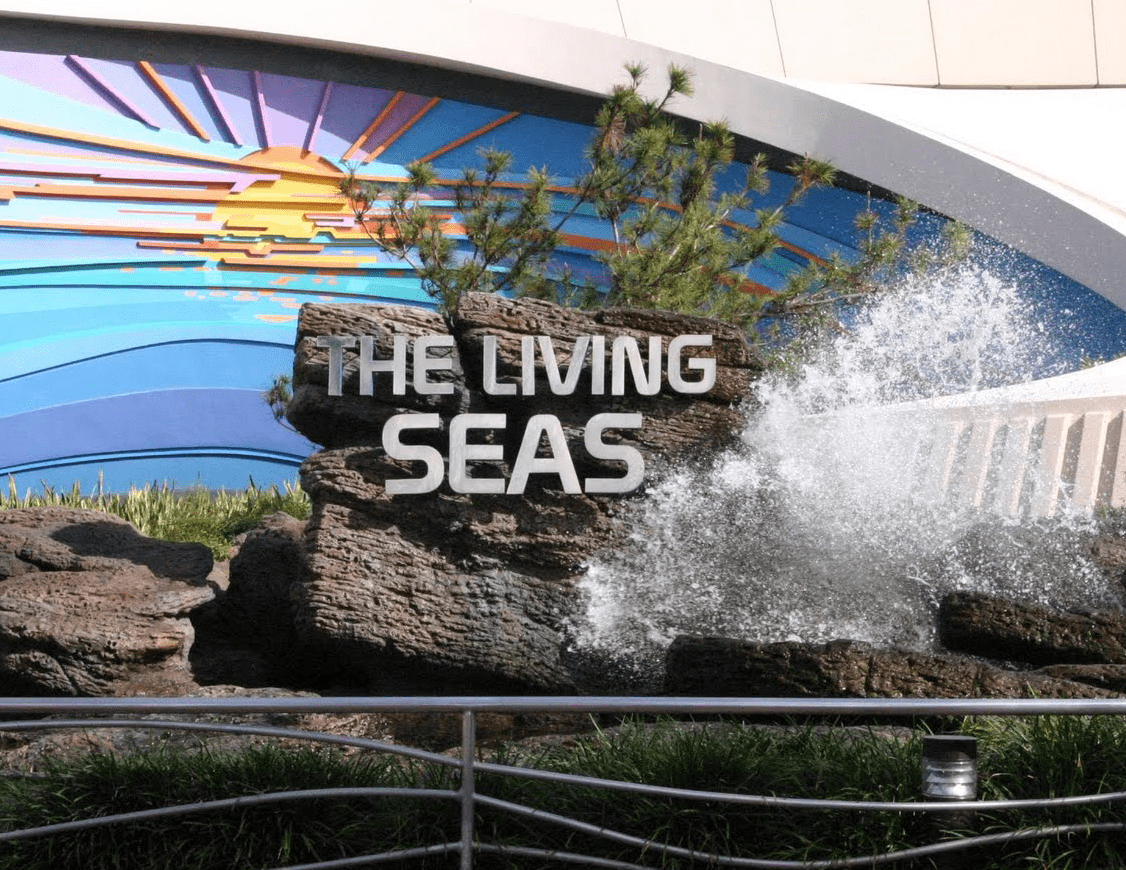
In 1986, EPCOT introduced guests to the briny deep of the world’s oceans. At the time of its completion, The Living Seas pavilion housed the largest saltwater tank in the world – holding a whopping 5.7 million US gallons of water. Aside from the impressive multi-level aquarium, the pavilion also hosted a truly immersive dark ride. Guests were welcomed to board “hydrolators” for a trip to the bottom of the ocean, where they rode Seacabs on a trip through the middle of the giant tank. Post-aquarium exhibits continued the sea-based learning experience for guests.
The pavilion’s waning popularity, contrasted with the immense popularity of Pixar’s 2003 film Finding Nemo, prompted a reimagining of the pavilion in 2005 to a themed experience – The Seas With Nemo & Friends. The dark ride now projects Nemo, Dory, and others from the Pixar film franchise among the natural residents of the aquarium. One of Disney’s more interactive attractions – Turtle Talk With Crush – offers smaller guests the chance to interact with their favorite laid-back sea turtle for an amusing question-and-answer session.
The Living Seas Icon

This pair of waves cresting upon each other represent the ocean blue, and its residents that await guests inside the pavilion. This is one of the more intuitive icons of the Future World pavilions.
Wonders of Life
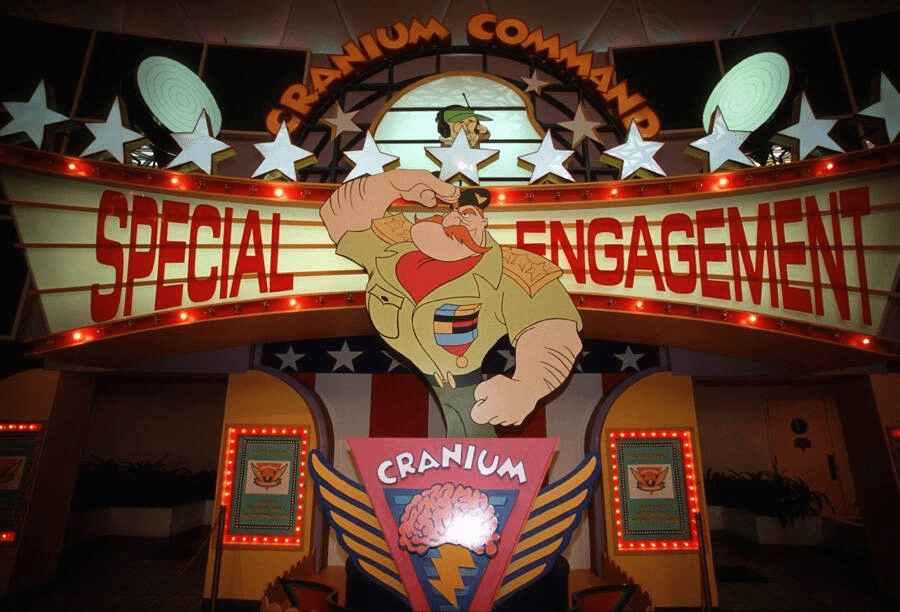
“Is there a doctor in the house?” Look no further than the Wonders of Life. This pavilion – devoted to health care, the human body, and nutrition – opened in 1989. The pavilion’s sponsor was, fittingly, MetLife Insurance. A theme park pavilion based on health and the human body doesn’t sound very exciting, but Disney Imagineers crafted the pavilion’s attractions to spice up the subject matter.
Body Wars was a motion simulator ride which shrunk guests down to the size of a blood cell so they could study a splinter lodged in a human finger. Of course, the simple observation mission went awry, and guests narrowly escaped a frantic tour of the human body, including the heart, lungs, and brain. Fun fact: Body Wars is considered to be EPCOT’s first thrill ride, and the turbulence of the attraction gave some riders nausea.
Cranium Command – a theater-style show attraction – was a humorous presentation on the importance of the human brain. The show was hosted by Buzzy, who looked at the world through the eyes of a twelve-year-old boy, with the help of a host of body organs and their competing priorities. Does this situation sound familiar? Pixar’s 2015 film Inside Out featured a similar style of competing sentiments, but based on emotions rather than the body’s physiological functions.
MetLife ended its sponsorship of the Wonders of Life pavilion in June 2001, which led to the slow decline of the pavilion. In 2004, Disney reduced the pavilion’s operational schedule to “seasonal” (which is a Disney’s code for “it will be closing before too much longer”). Sure enough, the pavilion closed for good in January 2007. The pavilion’s trademark gold dome still exists, and is used for corporate events and occasional EPCOT special events. In March 2019, Disney announced a transformation of the space to an upcoming Play! pavilion.
The Wonders of Life Icon

This may be the most straightforward icon of all classic EPCOT pavilions. The human body is present front-and-center, bordered by a pentagon shape – representing the body’s five senses.
I hope you enjoyed this brief tour back through time to the early days of EPCOT’s Future World. Do you have a favorite classic EPCOT pavilion or attraction? Let us know with a message on social at: Instagram Facebook X




